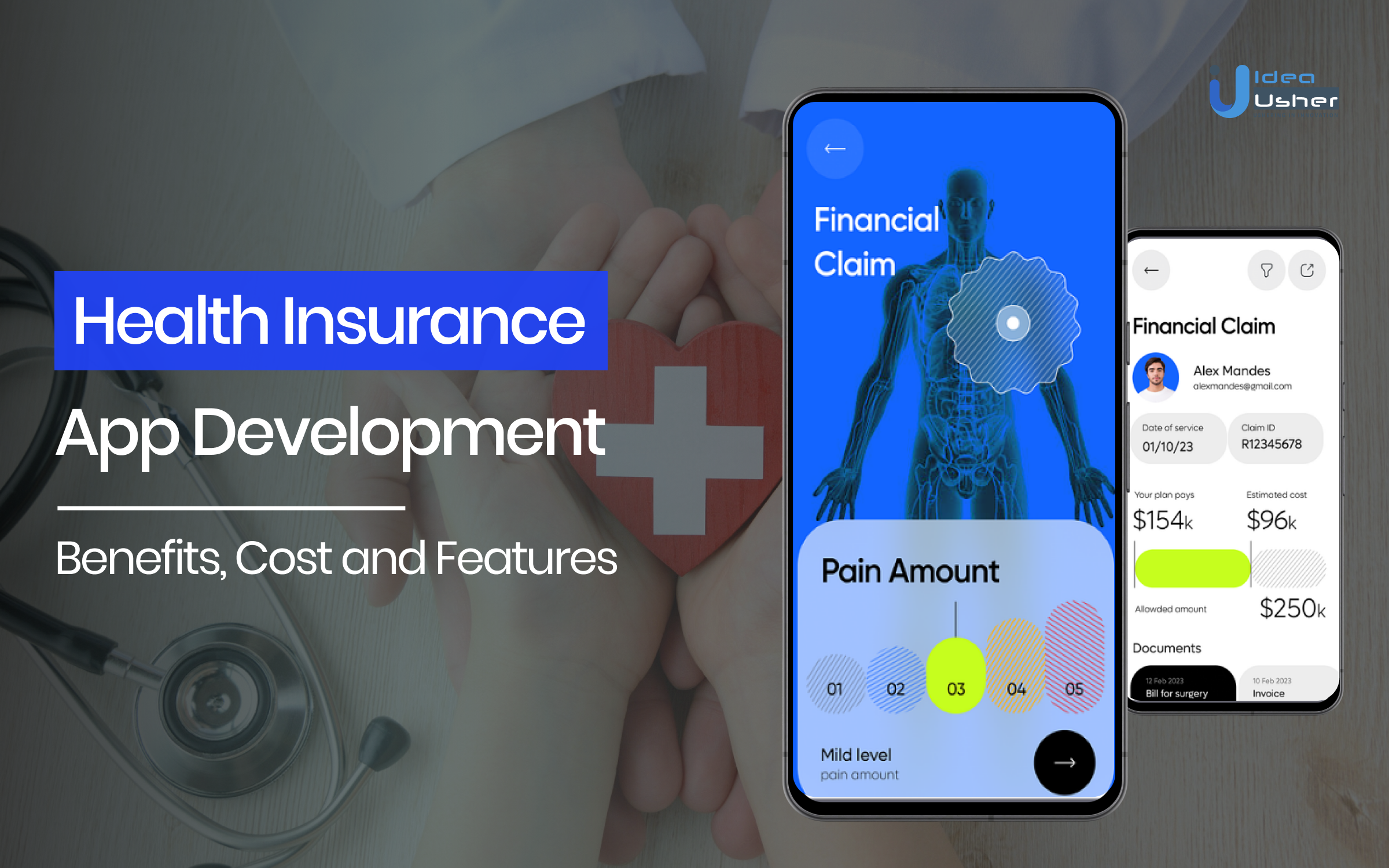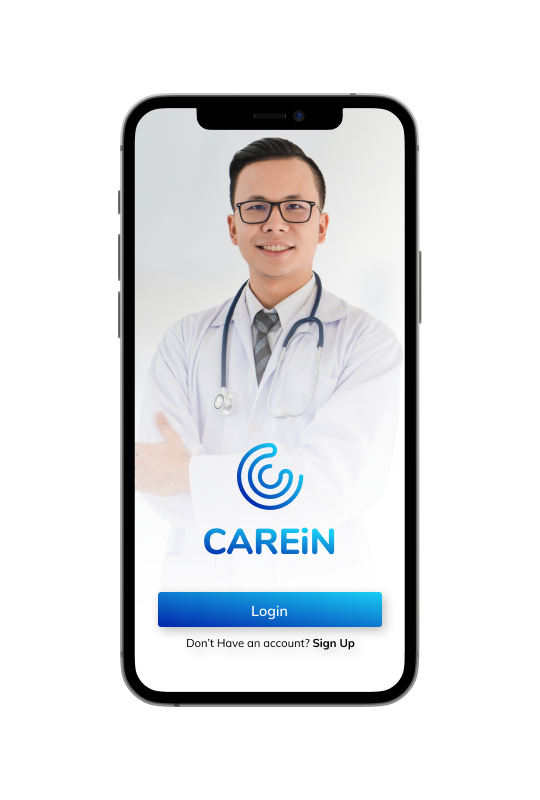The way we handle health insurance is undergoing a major upgrade every day! With the healthcare market nearing $11 trillion, the push for smarter, more accessible tools is stronger than ever, and Health insurance apps are no exception. These apps are stepping in to meet this demand while offering users immediate access to policy information and claims processing. These digital solutions streamline management related to insurance processes and claims, cut costs, and improve security.
Over 80% of adults are expected to engage in digital health services in the coming years, and it is obvious that health insurance apps will emerge as a vital resource for both users and providers. Since these apps are key to meeting the demand for convenience and accessibility in health insurance management, we will understand the development process of these apps and outline the benefits, features, and required financial investment.
Health Insurance Applications: Overview
Health insurance applications are digital platforms that make managing your health insurance easier. They let you apply for health coverage online or through an app. You can fill out forms, and the system often helps speed up the approval process. These apps also allow you to compare different insurance plans by looking at costs and coverage options, helping you choose the best plan for your needs. Once you pick a plan, you can enroll directly through the app, often with simple, secure steps. Additionally, you can use these applications to update your personal details, add or remove family members, and renew your coverage. Overall, health insurance apps make it simpler to manage your insurance, saving you time and effort.
Key Features Of Health Insurance App
Here are the features of a well-crafted health insurance app that streamlines the management of health coverage:
- Policy Overview: Access detailed information about your health insurance policy, including coverage limits, benefits, and key terms. This feature ensures you understand your plan thoroughly.
- Claims Management: Easily submit and track claims directly through the app. It simplifies the process by allowing document uploads and providing real-time status updates.
- Provider Directory: Find healthcare providers and specialists within your network. Search and filter by location and specialty, and view ratings and contact details to make informed choices.
- Digital ID Cards: Use virtual insurance cards for quick access during medical visits. These digital cards include important policy details and can be easily retrieved from your mobile device.
- Telehealth Services: Schedule and attend virtual consultations with healthcare professionals through the app. This feature supports video calls and secure communication, offering convenient access to medical advice.
- Prescription Tracking: Manage your prescriptions with ease. Set refill reminders, track medication schedules, and request refills directly from the app.
Features of Healthcare Insurance App Panels:
| User Panel | Provider Panel | Admin Panel |
| User Profile Management | Patient Appointment Management | User Account Management |
| Policy Information | Verify Insurance Coverage | Claims Processing |
| Payment Management | Submit Claims | Policy Information Management |
| Claims Tracking and Submissions | Access Patient Health Records | Customer Support Management |
| Virtual ID Cards | Manage Patient Appointments | Report Generation |
| Provider Lookup | Update Patient Treatment Records | Analytics and Insights |
| Teleconsultation Services | Communication with Patients | System Configuration |
| Prescription Management | Billing and Invoicing | User Role Management |
| Push Notifications | Access to EHR Systems | Data Security and Compliance |
| 24/7 Support | Treatment Plan Management | Notification Management |
| Symptom Checker | Patient History Access | Audit Logs |
| Condition Management | Prescription Management | Integration with External Systems |
| Document Access and Sharing | Communication with Insurance Admins | Performance Monitoring |
| Transparent Billing and Payments | Appointment Scheduling | Fraud Detection and Prevention |
| In-App Calling and Live Chat | Patient Feedback Collection | System Maintenance |
| Video Conferencing with Doctors | Teleconsultation Scheduling | Backup and Recovery |
How Does The Health Insurance App Work?
The workflow of a healthcare insurance app involves several key steps:
- Users start by downloading the app and creating an account with their personal information.
- They then set up their profile, including insurance preferences and details.
- Once logged in, they can view comprehensive policy information, such as coverage and benefits.
- Users can submit and track insurance claims directly through the app.
- The app helps them find healthcare providers within their network and provides digital insurance ID cards for easy use.
- It also offers virtual consultations with healthcare professionals and manages prescriptions by tracking medication and setting refill reminders.
- Users can handle premium payments, view billing history, and receive payment reminders.
- The app sends push notifications for policy updates and important reminders and provides 24/7 customer support for any issues.
Global Health Insurance Market Takeaway
The global health insurance market is set to grow significantly. By 2024, the market size is expected to reach $2.38 trillion in premiums. On average, people are expected to spend $306.70 per person on health insurance in 2024. Furthermore, the market is projected to grow at a rate of 2.43% per year from 2024 to 2028, reaching $2.62 trillion by 2028.
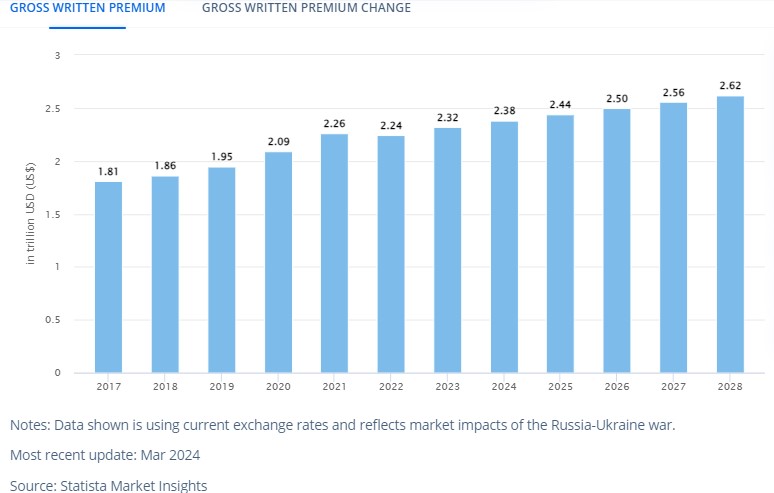
In the United States, the health insurance market is the largest, with an estimated premium total of $1,607 billion in 2024.
Current Trends And Future Outlook
The health insurance industry is increasingly moving towards digital platforms and telemedicine. This means more people are using online services and virtual consultations to manage their health coverage.
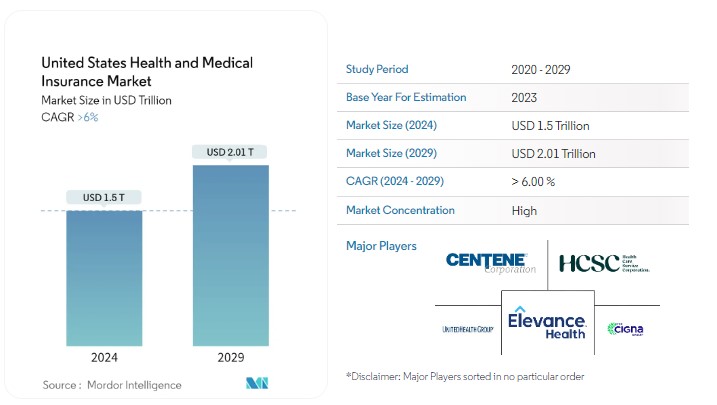
In the U.S., the health and medical insurance market is also growing rapidly. It’s expected to expand from $1.5 trillion in 2024 to $2.01 trillion by 2029, with a growth rate of over 6% each year. This growth is driven by higher demand for comprehensive insurance and new digital tools that make managing health care easier.
Types Of Health Insurance Applications
Health insurance applications come in various forms, each designed to meet specific needs and preferences. Here are some of the different types:
1. Health Maintenance Organization Apps
HMO apps provide users with access to a network of doctors and hospitals. Typically, users need a referral from their primary care physician to visit specialists, keeping care coordinated within the network. A well-known example of this is Kaiser Permanente, which offers an app that connects users to its extensive network of healthcare providers and manages specialist referrals.
2. Preferred Provider Organization Apps
PPO apps give users more flexibility in choosing healthcare providers. Unlike HMO plans, users can visit any doctor or specialist without needing a referral, although staying within the network is usually more cost-effective. An example of this is the Blue Cross Blue Shield PPO app, which allows users to freely select their healthcare providers while offering lower costs for in-network services.
3. Exclusive Provider Organization Apps
Similar to PPOs, EPO apps offer users access to a specific network of providers. However, users must stick to in-network providers except in emergencies, and no referrals are required for specialists. For example, the Cigna EPO app allows users to easily navigate their provider network without the need for referrals but emphasizes using in-network providers for routine care.
4. Point-of-Service Apps
POS apps blend features from both HMO and PPO plans. Users typically need a referral to see specialists but can choose between in-network and out-of-network providers, with higher costs for out-of-network services. A prime example is the Aetna POS app, which offers users the flexibility to opt for either in-network care with referrals or out-of-network care at a higher expense.
5. High-Deductible Health Plans Apps
HDHP apps cater to users who prefer lower monthly premiums in exchange for higher out-of-pocket costs. These plans are often paired with Health Savings Accounts (HSAs) to help cover medical expenses. For example, UnitedHealthcare provides an HDHP app that offers users a way to manage their health savings accounts while balancing low premiums with higher deductibles.
6. Medicare and Medicaid Apps
For users eligible for government-sponsored programs like Medicare and Medicaid, specialized apps help them manage their benefits. MyMedicare.gov is an example of an app that assists Medicare beneficiaries with managing their coverage, while Medicaid.gov offers resources and information for Medicaid users to easily access services and track benefits.
7. Marketplace or ACA Plans
Marketplace apps help users navigate and enroll in health insurance plans through the Affordable Care Act, “ACA.” These plans focus on preventive care and cover pre-existing conditions. A widely used app is HealthCare.gov, which helps users find ACA-compliant plans that meet their healthcare and financial needs, making the enrollment process smooth and straightforward.
Benefits Of Health Insurance App
Health insurance apps offer several important benefits for businesses. Below are some key advantages:
1. Enhanced User Experience
A health insurance app provides users with easy access to their insurance information and services. This convenience helps users manage their coverage more effectively and improves their overall experience.
2. Streamlined Processes
An app can simplify and automate processes such as claims submission and benefits management. This reduces the need for manual handling and paperwork, making it easier for users to interact with their insurance provider.
3. Cost Efficiency
Developing a health insurance app can lead to cost savings. By automating tasks and reducing administrative overhead, you can lower operational expenses. Additionally, offering features like preventive care can help users avoid higher medical costs in the long run.
4. Valuable Insights
The app can provide valuable data on user health trends and behavior. This information can be used to refine insurance offerings, enhance user engagement, and identify opportunities for improving services.
5. Regulatory Compliance
Health insurance apps are designed to comply with regulations such as HIPAA, ensuring that user data is handled securely and in accordance with legal standards. This helps maintain user trust and avoids potential legal issues.
6. Personalized Features
Many apps offer personalized recommendations based on user data. This personalized approach helps users receive more relevant information and services, enhancing their satisfaction and engagement with the app.
7. Market Competitiveness
Offering a well-designed health insurance app can differentiate your services from competitors. It shows a commitment to innovation and user-centric solutions, which can attract more customers and enhance your market position.
Must-have Features For Health Insurance Applications
When creating a health insurance app, adding key features can greatly improve how well it works and how satisfied users are. Here are some important features and examples of how top apps use them:
1. In-App Communication Tools
Integrating in-app calling and live chat allows users to connect directly with customer support or healthcare providers, facilitating smooth communication. For example, Oscar Health incorporates these tools and enables users to receive immediate assistance and resolve issues without leaving the app. This feature ensures users have quick access to necessary support and expert advice.
2. Symptom Checker
A symptom checker tool empowers users to enter their symptoms and receive preliminary guidance on whether they should seek medical attention. Aetna utilizes this feature effectively in its app and helps users assess their health and decide on appropriate next steps. By providing actionable insights, this tool can reduce unnecessary doctor visits and promote timely care.
3. Chronic Condition Management
Tools designed for managing chronic conditions such as diabetes or hypertension are important. These features offer personalized care plans, tracking, and reminders. For example, Cigna includes condition management tools in its app, which help users monitor and manage their health more effectively. This leads to improved health outcomes and potentially lower healthcare costs.
4. Transparent Billing and Payment
A feature that provides clear billing information and payment options directly within the app is essential for managing healthcare expenses. Humana excels in this area and offers detailed billing and payment capabilities that help users understand their financial commitments and manage payments more efficiently. This transparency helps users avoid unexpected costs and streamline their financial management.
5. EHR Integration
Integrating EHR systems allows users to access their medical records, lab results, and appointment history through the app. Kaiser Permanente demonstrates this feature well by providing users with seamless access to their health information. This integration enhances care coordination and improves communication between users and healthcare providers.
6. Video Consultations
Including video conferencing capabilities in the app enables users to have non-emergency consultations with doctors remotely. myCigna offers this feature and allows users to access medical advice without the need for in-person visits. Video consultations save time and reduce exposure to illnesses while providing a convenient alternative for users.
7. Document Management
Finally, enabling users to access and share important documents, such as policy details and medical reports, through the app simplifies document management. Anthem provides this functionality, which helps users manage their health insurance documents more efficiently and reduces the need for physical paperwork.
Development Steps For Health Insurance Mobile Applications
Developing a health insurance mobile application involves several important steps to ensure it meets user needs and complies with regulatory standards.
1. Ensure Regulatory Compliance
Start by making sure your app meets all necessary regulations. This means following rules like HIPAA for protecting user data and GDPR for privacy. You also need to understand and comply with state-specific laws that may affect how the app works.
2. Integrate With Healthcare Providers
Set up your app to connect with healthcare providers. This involves creating APIs that allow the app to process claims, search for providers, and schedule appointments in real-time. Make sure the system securely exchanges information to keep everything accurate and up-to-date.
3. Personalize The User Experience
Make the app user-friendly by personalizing the experience. Offer recommendations based on users’ health data and preferences. Include features to track health metrics like steps and sleep so users get insights personalized to their needs.
4. Simplify Claim Processing
Streamline how users submit and manage claims. Allow them to upload documents and fill out forms easily. Provide real-time updates on the status of their claims and use automation to speed up processing and reduce mistakes.
5. Implement Secure Payment Options
Ensure that the app handles payments securely. Follow PCI DSS standards to protect payment information. Offer various payment methods, such as credit cards, debit cards, and digital wallets, to accommodate different user preferences.
6. Provide Health Education And Resources
Add valuable health content to the app. This can include articles, videos, and quizzes based on user interests. Provide information on diseases and treatments and allow users to schedule virtual consultations with healthcare professionals.
7. Include Emergency Assistance
Incorporate features for emergency support. Offer 24/7 customer service to help users with urgent issues. Allow users to store emergency contact details for quick access when needed.
8. Use Data Analytics
Analyze user data to improve the app. Look at trends and preferences to understand what works and what needs improvement. Use this information to make informed decisions and enhance the app’s features and functionality.
Tech Stack For Health Insurance App Development
Here’s a comprehensive tech stack for developing a health insurance app:
| Category | Technology | Description |
| Frontend Technologies | React Native | For building cross-platform mobile apps. |
| React.js | For developing web applications. | |
| Electron.js | For creating desktop applications. | |
| Backend Technologies | Node.js | For server-side development. |
| Express.js | A web application framework for Node.js. | |
| Django | A high-level Python web framework. | |
| Programming Languages | JavaScript | For both frontend and backend development. |
| Python | For backend development and data processing. | |
| Java | For building robust and scalable applications. | |
| Database Management | PostgreSQL | A powerful, open-source relational database. |
| MongoDB | A NoSQL database for handling large volumes of unstructured data. | |
| Cloud Services | AWS (Amazon Web Services) | For scalable cloud hosting and services. |
| Google Cloud Platform | For cloud computing services. | |
| Security Tools | OAuth 2.0 | For secure authorization. |
| JWT (JSON Web Tokens) | For secure token-based authentication. | |
| SSL/TLS | For encrypting data in transit. | |
| Additional Tools | Docker | For containerization and deployment. |
| Kubernetes | For container orchestration. | |
| Git | For version control and collaboration. |
Top Ways To Make Money With A Health Insurance App
Health insurance apps can make money through smart strategies. Here are the profitable methods:
1. Collaborate With Healthcare Providers
Partner with healthcare providers to earn referral fees when users sign up through their recommendations. You can also create joint wellness programs or special offers with these providers to attract more users. Additionally, setting up agreements to share anonymized health data can provide valuable insights while generating extra revenue.
2. Offer Insurance Premium Discounts
Encourage users to stay active in the app by offering discounts on their insurance premiums for meeting certain health goals. You can also work with insurance companies to develop wellness programs that reward users for maintaining healthy habits. This not only boosts app engagement but also helps retain users.
3. Provide Telehealth Services
Include telehealth services like virtual consultations within the app, allowing users to easily book and attend doctor appointments online. Offering remote monitoring services, such as tracking vital signs or managing chronic conditions, can also be a premium feature that adds value and attracts more users.
4. Use Health Risk Assessments
Integrate tools that assess users’ health risks and offer personalized advice. This can help you set customized insurance premiums based on each user’s health profile. Providing customized pricing models can make your app more appealing and relevant to individual users.
5. Monetize Health Data
License anonymized user health data to researchers or healthcare organizations. This can create an additional revenue stream while ensuring user privacy. You can also use insights from this data to develop new products or services that address emerging user needs.
6. Integrate With Third-Party Devices
Connect your app with fitness trackers to monitor users’ activity levels and offer rewards based on their data. Integrating with medical devices, like blood pressure monitors, can also enhance the app’s functionality and provide real-time health information, making the app more valuable for users managing chronic conditions.
7. Offer Educational And Coaching Services
Provide valuable educational content on health topics such as disease prevention and healthy living. This can attract users who want reliable health information. Additionally, offer premium health coaching services to help users achieve their health goals, creating another revenue stream through subscriptions or one-time payments.
Cost Of Developing A Health Insurance App
Here’s a detailed breakdown of the cost of developing a health insurance app:
| Component | Cost Range (Minimum) | Cost Range (Maximum) |
| Research and Planning | $300 | $3,000 |
| Frontend Development | $1,000 | $18,000 |
| Backend Development | $1,500 | $22,000 |
| App Features | – | – |
| User Profile Management | $300 | $5,000 |
| Policy Information | $500 | $5,000 |
| Payment Management | $800 | $5,000 |
| Claims Tracking and Submissions | $700 | $5,000 |
| Virtual ID Cards | $200 | $3,000 |
| Provider Lookup | $600 | $5,000 |
| Teleconsultation Services | $800 | $5,000 |
| Prescription Management | $500 | $5,000 |
| Push Notifications | $400 | $3,000 |
| 24/7 Support | $400 | $5000 |
| Testing and Quality Assurance | $500 | $3000 |
| Deployment | $500 | $3000 |
| Maintenance and Updates (per year) | $1000 | $5000 |
| Total Cost Range | $10,000 | $100,000 |
Cost-Affecting Factors To Consider For Health Insurance App
Developing a health insurance app involves several key factors that can influence the cost:
- Compliance and Certification: Your app must follow regulations like HIPAA or GDPR, which can be costly. This ensures user data is protected and the app meets legal standards.
- Data Security: Securing sensitive health data requires advanced encryption and storage solutions. Implementing these security measures can increase development costs.
- Integration with Existing Systems: Connecting your app with healthcare systems, such as EHR, can be complex and pricey. It involves technical work to ensure smooth communication between systems.
- Teleconsultation Features: Adding video conferencing and chat services for remote consultations requires extra development and infrastructure, which can raise the overall cost.
- Claims Processing: Building features for submitting and tracking insurance claims involves complex workflows and integrations with insurance providers. This can be resource-intensive and costly.
- Provider Network Management: Creating and maintaining an up-to-date database of healthcare providers requires ongoing effort and resources, impacting the app’s cost.
Top 5 Leading Health Insurance Apps In 2024
Here are the top five health insurance apps of 2024, known for their innovative features and user-centric design:
1. Kaiser Permanente
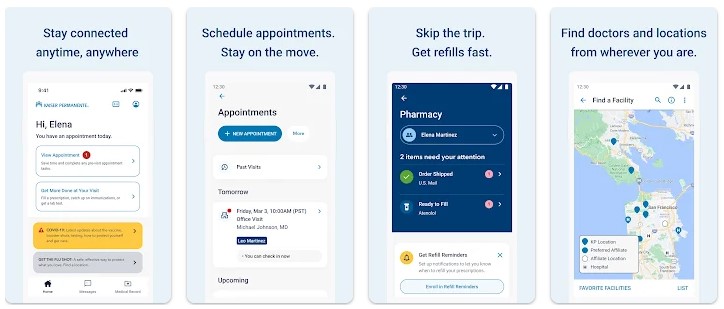
Kaiser Permanente’s app excels by offering a unified experience with its HMO and EPO plans. It allows users to easily access their medical records, schedule appointments, and use telehealth services. This integration ensures that managing healthcare is straightforward and efficient.
2. Blue Cross Blue Shield
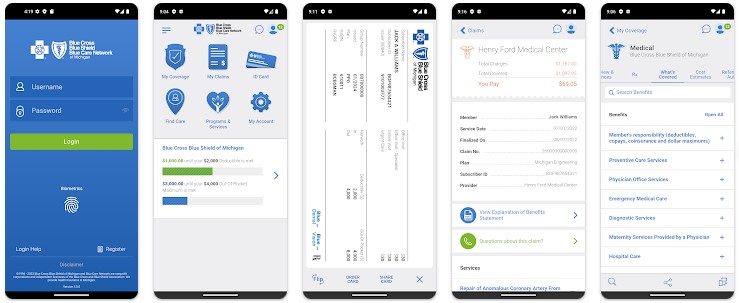
The Blue Cross Blue Shield app is known for its user-friendly features, including policy management, claims tracking, and provider lookup. It is highly rated due to its broad network of providers and its effective customer service, making it easy for users to manage their insurance needs.
3. UnitedHealthcare
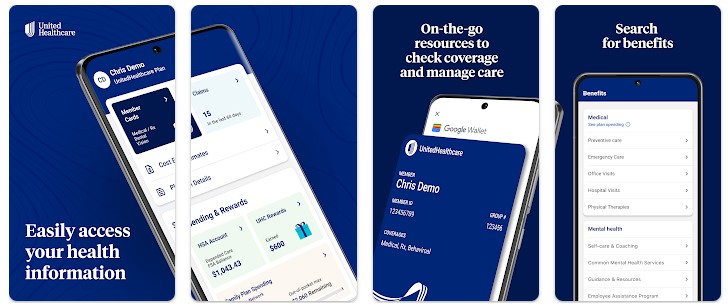
UnitedHealthcare’s app stands out for its useful tools like virtual ID cards and teleconsultation services. It also offers condition management features to help users handle chronic conditions. Its well-designed interface and extensive provider network make it a popular choice.
4. Aetna
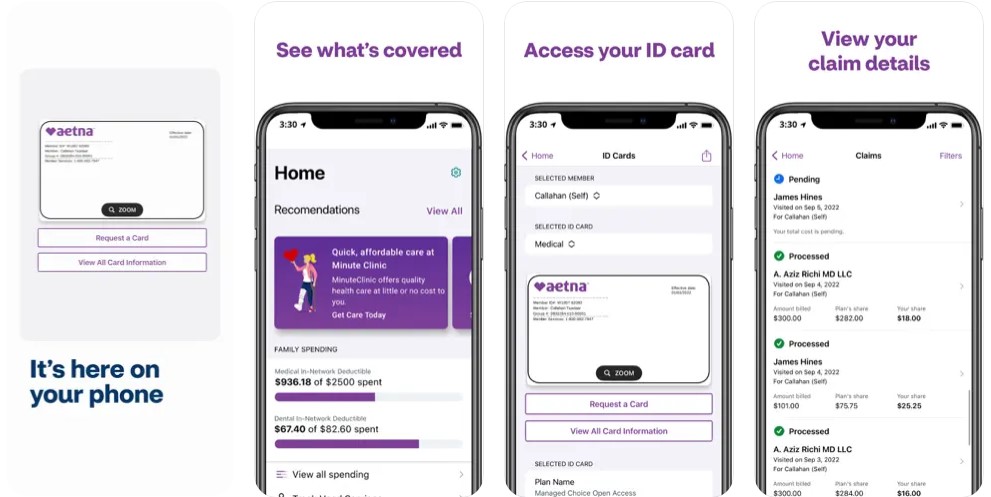
Aetna’s app is appreciated for its simplicity and practicality. It includes a symptom checker, prescription management, and clear billing options. These features make it easy for users, especially younger ones, to manage their health and understand their costs.
5. Anthem
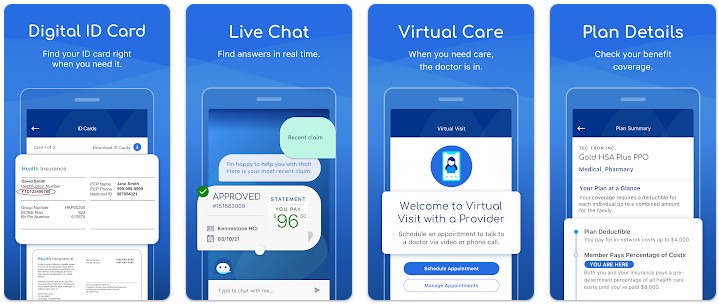
Anthem’s app is designed to improve user support with features such as document access, in-app calling, and live chat. These tools help users quickly find information and get help directly from the app, making insurance management more convenient.
Conclusion
Health insurance apps are changing the ways we manage our health coverage by adding convenience and efficiency to the process. They simplify the complexities of insurance, making it easier for users to access essential services. With ongoing advancements, these apps are expected to become even more organized and user-friendly. So, developing a health insurance app now offers a chance to streamline these complex processes and enhance user experience. As more people embrace digital tools, creating a well-designed health insurance app could lead to improved service and higher customer satisfaction.
Looking To Develop A Health Insurance App?
We are here to assist. We combine 10+ years of industry expertise with over 50,000 hours of coding experience. We’ve successfully delivered more than 200 projects, including several specialized healthcare and Insurtech apps. Our deep experience in developing customized solutions conveys that we can definitely deliver a health insurance app that can meet your needs and excel in functionality and user engagement. So, get in touch with us today and build an effective app that simplifies complex processes and enhances user satisfaction. Partner with us for a cutting-edge health insurance app that stands out in the market.
Work with Ex-MAANG developers to build next-gen apps schedule your consultation now
FAQ
What is a health insurance app?
A health insurance app is a mobile or web application designed to help users manage their health insurance needs. It typically offers features such as policy information, claims tracking, premium payments, and access to network providers. These apps aim to streamline insurance processes and improve user convenience and satisfaction.
How to create an insurance app?
To create an insurance app, start by defining the app’s core functionalities and target audience. Next, design a user-friendly interface and develop the backend infrastructure. Integrate features like policy management, claims processing, and payment gateways. Finally, test the app rigorously, ensuring compliance with relevant regulations and security standards before launching.
How much does it cost to develop a healthcare app?
The cost to develop a healthcare app varies widely based on complexity, features, and development region. On average, it ranges from $10,000 to $100,000. Factors influencing cost include design, development time, and integration with health systems. Customized solutions or advanced features can significantly increase the total development cost.
How long does it take to develop a healthcare insurance app?
Developing a healthcare insurance app typically takes between 3 to 6 months. This timeframe includes stages such as planning, design, development, testing, and deployment. The duration can vary depending on the app’s complexity, feature set, and any regulatory compliance requirements, as well as the efficiency of the development team.
